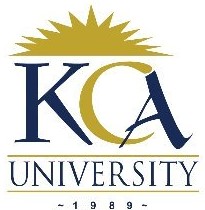
UNIVERSITY EXAMINATIONS: 2014/2015
ORDINARY EXAMINATION FOR THE BACHELOR OF SCIENCE
IN INFORMATION TECHNOLOGY
BIT 3204 DISTRIBUTED MULTIMEDIA SYSTEMS
DATE: DECEMBER, 2014 TIME: 2 HOURS
INSTRUCTIONS: Answer Question ONE and any other TWO
QUESTION ONE (30 MARKS) [compulsory]
(a) What are the key distinctions between multimedia data and more conventional
types of media? (4 Marks)
b) Why is data compression necessary for Multimedia activities? (2 Marks)
c) State four benefits of streaming as opposed to downloading multimedia data.
(4 Marks)
e) A graphic image has a resolution of 800X450 and colour bit depth of 24 bits.
Calculate
i) Pixel count (2 mark)
ii) Number of bits in the image (2 Marks)
iii) File size in Megabytes (3 Marks)
iv) If the number of frame per second is 25 for the camera in (e) calculate size of
the video in Gigabytes ( 3 Marks)
v) What should be the CODECs compression ratio if the video is to be distributed
on ONE DVD? (4 Marks)
vi) How many hours would it take to download it if the internet bandwidth is
1MBps? (3 Marks)
vi) How many days would it take for 10 users to download the video if they
access the internet at the same time (3 Marks)
QUESTION TWO (20 MARKS)
a) State SIX components of a multimedia workstation (6 Marks)
b) Distinguish between
i) multimedia and hypermedia (2
Marks)
ii) rate monotonic scheduling and earliest deadline first in real-time scheduling.
(4 Marks)
iii) Intra object synchronization and inter object synchronization. (2
Marks)
c) What is the function of a set top box (2 Marks)
d) Identify any FOUR digital broadcast standards (4 Marks)
QUESTION THREE (20 MARKS)
a) State five causes of streaming quality of video (5 Marks)
b) State four reasons why synchronization is complex in distributed environments.
(4 Marks)
c) Define digital convergence (3 Marks)
d) Distinguish between PAL and NTSC in analogue television (4 Marks)
e) Why is distributed multimedia different from conventional operating systems?
(4 Marks)
QUESTION FOUR (20 MARKS)
a) What is session management in distributed multimedia systems (2 Marks)
b) State FOUR phases in resource reservation (4 Marks)
c) Identify SIX characteristics of multimedia databases (6 Marks)
d) Using Huffman coding technique with the following frequencies
A B C D E
16 17 32 18 10
i) Huffman tree (2 Marks)
ii) Encode ECEBEABDE (2 Marks)
e) Using Lempel Ziv technique encode AABBCDABBAA (4 Marks)
QUESTION FIVE [20 MARKS]
a) How much space does it take to store an RGB 640×480 pixel picture? (3 Marks)
b) What are the two types of real-time multimedia streaming (2 Marks)
c) Describe the following multimedia applications
i) Virtual Reality (VR) (5 Marks)
ii) Video conferencing (5 Marks)
i) IPTV (5 Marks)